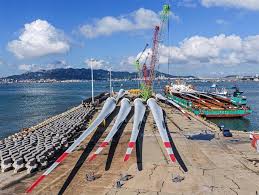Foreign
China’s commitment bolsters global confidence in climate governance

By He Yin, People’s Daily
On Sept. 24, Chinese President Xi Jinping delivered video remarks at the United Nations Climate Summit held in New York, putting forward three proposals on advancing global climate governance to firm up confidence, live up to responsibilities, and deepen cooperation. He also announced China’s new Nationally Determined Contributions (NDCs).
At this critical juncture in global climate governance, China’s vision and solutions exemplify the role of a responsible major country and significantly boost international confidence in advancing the climate agenda.
This year marks the 10th anniversary of the Paris Agreement, a pivotal year for countries to submit their new NDCs. At this important moment, China is determined to be a contributor to and doer in advancing global climate governance.
In his remarks, Xi announced to the world that China will, by 2035, reduce economy-wide net greenhouse gas emissions by 7 to 10 percent from peak levels, striving to do better; increase the share of non-fossil fuels in total energy consumption to over 30 percent; expand the installed capacity of wind and solar power to over six times the 2020 levels, striving to bring the total to 3,600 gigawatts; scale up the total forest stock volume to over 24 billion cubic meters; make new energy vehicles the mainstream in the sales of new vehicles; expand the National Carbon Emissions Trading Market to cover major high-emission sectors; and basically establish a climate adaptive society.
These targets and measures represent China’s maximum efforts in setting goals consistent with the requirements of the Paris Agreement. They have quickly drawn international attention and broad commentary. Many observers regard the commitments as a landmark step and expect China to sustain momentum on climate action. Some argue that the move has reinvigorated global confidence in emissions reduction, and China’s clean energy boom will reshape the global economy.
Overall, analysts believe that China is accelerating its green transition, has the capacity to meet its goals, and is injecting renewed confidence into global climate governance.
Climate change is a shared challenge to the common interests of all humanity. Effective response requires collective wisdom, mobilized resources, and concrete global action.
To advance global climate governance, the world must firm up confidence. Green and low-carbon transition is the trend of the times. From Eurasia to the Americas, from the African highlands to the Pacific island countries, a broad international consensus has formed around pursuing sustainable development and tackling climate change together.
Green transition is both the only path to address climate change and a new driver of economic and social development. Looking ahead, the international community should stay focused on the right direction, remain unwavering in confidence, unremitting in actions and unrelenting in intensity, and push for formulation and delivery on NDCs, with a view to providing more positive energy to the cooperation on global climate governance.
To advance global climate governance, the world must live up to responsibilities. There is only one Earth for humanity. Protecting the environment and promoting sustainable development is a shared responsibility of all countries.
At present, achieving the goals of the Paris Agreement is challenged by insufficient implementation of NDCs, funding shortfalls, and delays in technology and capacity building. Fairness and equity should be upheld and the right to development of developing countries fully respected. The global green transition should serve to narrow rather than widen the North-South gap. Countries need to honor the principle of common but differentiated responsibilities, whereby developed countries should take the lead in fulfilling emission reduction obligations and provide more financial and technological support to developing countries.
To advance global climate governance, the world must deepen cooperation. The world today faces not only deficits in development and in green transition, but also deficits in trust and in governance. To overcome these deficits, countries must join hands to deepen cooperation, pool strengths for green development, and address the challenges of climate governance, instead of creating obstacles in green development and cooperation.
The world now faces a huge demand for green development. It is important that countries strengthen international coordination in green technologies and industries to address the shortfall in green production capacity and ensure free flow of quality green products globally, so that the benefits of green development can reach all corners of the world.
Addressing climate change is both an urgent and a long-term task. The trend of green and low-carbon transition is irreversible. By firming up confidence, living up to responsibilities, and deepening cooperation, all parties can work together to realize the beautiful vision of harmony between humanity and nature and safeguard the shared planet.
Foreign
BREAKING: Trump Orders Investigation into Reported Christian Killings in Nigeria

By: Fabian Apechihin
U.S. President Donald J. Trump has directed lawmakers to launch an immediate investigation into reports of widespread killings of Christians in Nigeria, describing the situation as a “Christian genocide.”
In a statement released Friday evening via his Truth Social platform, Trump expressed grave concern over the violence, blaming radical Islamist groups for what he called a “mass slaughter.”
“Christianity is facing an existential threat in Nigeria. Thousands of Christians are being killed. Radical Islamists are responsible for this mass slaughter,” he wrote.
The U.S. President announced that he is designating Nigeria a “Country of Particular Concern,” citing alarming figures of killings within the country compared to global totals.
“When Christians, or any such group, are slaughtered like is happening in Nigeria — something must be done! I am asking Congressman Riley Moore, together with Chairman Tom Cole and the House Appropriations Committee, to immediately look into this matter and report back to me,” Trump stated.
He added that the United States “cannot stand by while such atrocities are happening,” pledging that his administration remains ready “to protect Christian populations around the world.”
Foreign
China advances to the forefront of global science and technology

By Shi Ling, People’s Daily
Over the past five years, China has made significant strides in science and technology, positioning itself at the cutting edge of global innovation. Chinese researchers are now leading in key frontier domains, reflecting the nation’s growing capacity for original, foundational breakthroughs.
In quantum science, Chinese scientists have, for the first time, realized fractional quantum anomalous Hall states of photons. In life sciences, they have produced the first single-cell spatial map of the macaque cerebral cortex. In brain-computer interface research, new technologies have enabled paralyzed patients to regain mobility and restored light perception in the visually impaired.
These advances underscore the country’s expanding ability to generate original innovations. As a result, new industries and business models are emerging, propelling China closer to its goal of becoming a science and technology giant.
Frontier technologies, defined by their foresight, pioneering potential, and exploratory significance, represent the future direction of global scientific and technological progress. In many of these domains, China has moved from a follower to a forerunner and in some areas, to a pacesetter. What lessons can be drawn from this transformation?
To push the frontiers, it is essential to anticipate emerging trends and take the initiative.
Artificial intelligence (AI) is transforming daily life, with applications ranging from intelligent voice assistants and adaptive environmental systems to facial recognition and smart security. China’s global leadership in AI is underpinned by comprehensive top-level planning and the effective alignment of policy guidance with market-driven innovation.
China’s scientific and technological endeavors now span from the cosmic and the quantum, engage with extreme environments, and advance through interdisciplinary integration. A deep understanding of technological trajectories enables China to define development priorities, make forward-looking plans, and seize new opportunities.
To push the frontiers, it is essential to strengthen basic research and cultivate long-term perseverance.
Over the past five years, China has more than quadrupled the charging efficiency of power batteries, while its motor and electronic control technologies have reached globally leading standards. Despite entering the new energy vehicle sector later than Europe and the United States, China has achieved leapfrog development – driven by foundational technological breakthroughs.
As many researchers acknowledge, “Scientific discovery often comes from the final attempt after countless failures.” The nanoscale confinement catalysis theory for efficient and clean energy conversion emerged from more than 20 years of sustained research by Bao Xinhe’s team. Similarly, the development of a quantum simulator that surpasses classical computing reflects more than ten years of dedicated effort by Pan Jianwei’s team.
These original breakthroughs are underpinned by growing investment in basic research, a strategic balance between open-ended exploration and mission-driven focus, and the quiet dedication of countless researchers committed to the pursuit of scientific discovery.
To push the frontiers, it is essential to integrate innovation drivers and build a robust innovation ecosystem.
Ultrapure water is indispensable in semiconductor manufacturing. To meet the stringent “five parts per billion” impurity standard required for chip production, Chinese tech firm Sunresin conducted more than 200 iterations over three years, ultimately breaking foreign monopolies. Within this ecosystem, even failed experiments are not penalized – an evolving tolerance for failure allows researchers to focus wholeheartedly on solving complex challenges.
A mature innovation ecosystem fosters synergy among innovators and ensures the effective allocation of resources. In recent years, China has deepened its reform of science and technology evaluation mechanisms, shifting the emphasis toward innovation value, capacity, and real-world contributions. The integration of enterprises, universities, and research institutions has accelerated, spurring the rapid rise of technology-leading firms. Simultaneously, infrastructure, platforms, and academic systems are being reinforced, while the country’s high-level talent pool continues to expand. China is also deepening international cooperation and actively engaging in major global scientific programs. Through a model of independent, collaborative, and open innovation, China is creating a world-class environment for frontier breakthroughs.
At the inaugural World Humanoid Robot Games, a robot that once stumbled descending stairs went on to win the 100-meter dash, while on the football field, a tangle of clumsy robots drew laughter from the crowd. Behind these imperfect yet promising performances lies the momentum of an emerging industry, demonstrating the vitality and resilience of China’s innovation landscape.
Looking back, China has transformed its latecomer position into a strategic advantage, achieving remarkable progress across multiple sectors. Looking ahead, China will not only provide extensive application scenarios for scaling innovations, but also become an increasingly important source of original and disruptive scientific breakthroughs.
Foreign
Steady progress of China’s economy adds precious certainty to world

By He Yin, People’s Daily
On Oct. 20, China’s National Bureau of Statistics released data on the country’s economic performance for the first three quarters of 2025.
The figures indicate China’s GDP grew by 5.2 percent year on year, 0.2 and 0.4 percentage points higher than the growth rates for the whole of last year and the same period last year, respectively, laying a solid foundation for achieving the year’s main targets.
At a time when global growth momentum remains weak and uncertainty is mounting, China’s steady and sustained economic performance has become a valuable source of certainty for the world economy.
With a growth rate of 5.2 percent, China remains among the top performers among major economies and continues to serve as one of the most stable and reliable engines of global economic growth.
Despite mounting external pressures and internal challenges, China’s economy has demonstrated remarkable resilience: maintaining overall stability while achieving structural improvements in key sectors.
China’s total imports and exports of goods rose by 4 percent year-on-year in the first three quarters, underscoring strong resilience. As Reuters noted, this reflects China’s progress in diversifying both its export markets and product portfolio.
Amid headwinds against globalization, China’s emerging trade drivers continue to grow, market diversification advances steadily, and exports increasingly shift toward higher-value, technologically sophisticated goods. These developments contribute significantly to stabilizing global industrial and supply chains.
This economic stability stems from China’s disciplined focus on domestic priorities, leveraging high-quality development strategies to navigate global uncertainties.
Proactive and targeted macro policies have boosted consumption, upgraded industries, fostered new growth drivers, and kept economic circulation smooth while advancing high-standard opening up. These efforts have not only stabilized the economic fundamentals in the short term but also built momentum for long-term growth.
Notably, final consumption expenditure accounted for 53.5% of China’s GDP growth during this period, confirming its role as the economy’s primary driver.
The continued effects of major policies to strengthen the economy and foster new drivers, including those aligned with major national strategies, building up security capacity in key areas, as well as the large-scale renewal of equipment and the trade-in of consumer goods, have extended to the production side, stimulating sectors such as equipment and consumer goods manufacturing, and promoting green manufacturing and digital technology upgrades.
Efforts to build a unified national market have accelerated cross-regional flow of goods, talent, and capital, enhancing supply chain efficiency. With ample policy space, diverse tools, and well-prepared reserves, China has the capacity to ensure steady and sound economic performance.
At the recent 138th edition of the China Import and Export Fair, or the Canton Fair, booths showcasing robotics, smart manufacturing, and other high-tech products drew long lines of international visitors. As the integration of science, technology, and industry continues to deepen, more innovations are moving from laboratories to production lines, turning innovation potential into real economic momentum.
China is developing new quality productivity adapted to local conditions, optimizing economic structures, and facilitating orderly transitions between traditional and emerging growth drivers.
Traditional industries are embracing digital transformation through internet, AI, and digital technologies, accelerating equipment renewal and technological upgrades to gain new dynamism.
Wind and solar power generation recorded double-digit growth during the reporting period. Production of new energy vehicles surged 29.7% year-on-year, while automotive lithium-ion battery output increased 46.9 percent, making China’s economic growth greener.
As the 14th Five-Year Plan period (2021-2025) concludes, China’s economy has surpassed milestones of 110 trillion ($15.44 trillion), 120 trillion, and 130 trillion yuan, contributing around 30 percent of global growth annually. This makes China one of the world’s most important drivers of economic progress.
Despite profound changes unseen in a century, China has maintained overall economic stability, strengthened development foundations, and achieved new milestones in economic and social progress, laying a more solid groundwork and building greater confidence for the upcoming 15th Five-Year Plan period (2026-2030).
Amid global uncertainties, the fundamentals underpinning China’s economic stability, growth momentum, and resilience remain unchanged. Going forward, by giving full play to policy effectiveness, advancing high-quality development, and accelerating the development of new quality productive forces, China has both the confidence and the capability to sustain steady growth, and will continue to provide strong support for global economic recovery and development.
-

 Uncategorized5 years ago
Uncategorized5 years agoFG, states urged to harness flooding for ranching, others with technology – Agbaje
-

 Headlines10 years ago
Headlines10 years agoBreaking: EFCC seals Borno House of Assembly, as Hon members take to their heels
-

 News11 years ago
News11 years agoNigeria Security Operatives Stage Manhunt For Homosexual Perpetrator
-

 News9 years ago
News9 years agoHow 21-year-old Girl fled community over accusation of lesbianism
-

 News10 years ago
News10 years agoYobe Gov Moves Against Deputy
-

 Opinion6 years ago
Opinion6 years ago7 signs she has friend zoned you
-
Technology4 years ago
Online job placement company headhunts women
-

 Headlines9 years ago
Headlines9 years agoBorno Dep Gov Abducts Another Church Leader





